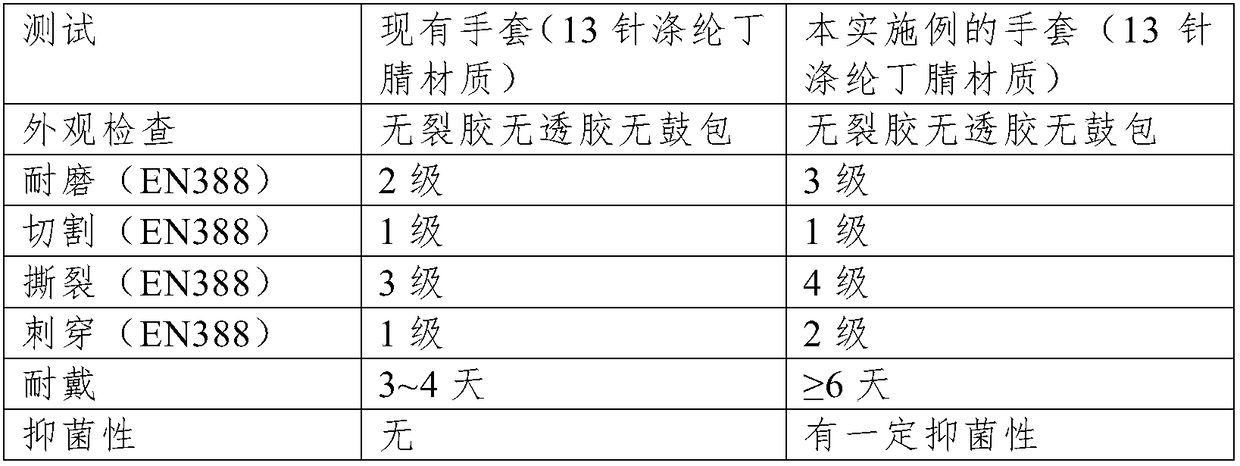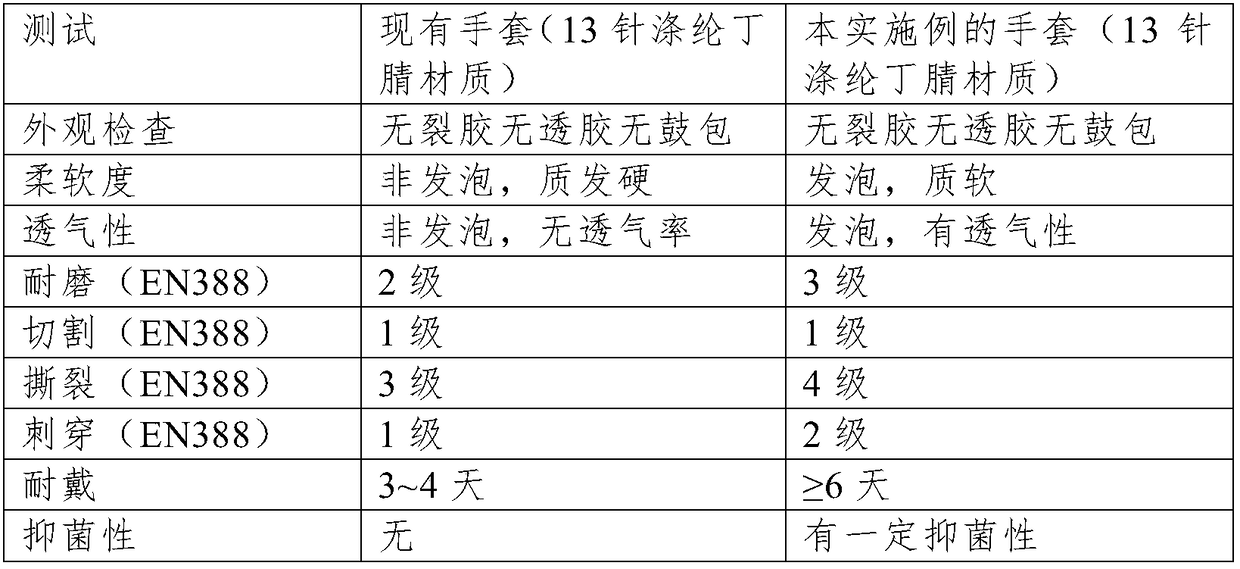Graphene laminated rubber glove and preparation method thereof
A technology of rubber gloves and graphene film, which is applied in the direction of gloves, conjugated diene coatings, clothing, etc., can solve the problems of rubber penetration (local penetration holes, rubber surface breaking, and webbing between fingers, etc., to ensure labor Protective effect, uniform, continuous and smooth rubber material, improving the effect of anti-friction
- Summary
- Abstract
- Description
- Claims
- Application Information
AI Technical Summary
Problems solved by technology
Method used
Image
Examples
Embodiment 1
[0039] Step S1: Prepare graphene-free glue: After mixing 100 parts by weight of pre-vulcanized nitrile latex with 2 parts of CMC (2% mass fraction), the obtained glue has a viscosity of 1800 mpa.s.
[0040] Step S2: immerse the knitted glove embryo at 50°C in 2.5% calcium nitrate methanol solution coagulant, and then immerse in the coagulant prepared in step S1, drip glue for 18 seconds, and homogenize the glue for 50 seconds.
[0041] Step S3: preparing graphene-latex dispersion: 100 parts by weight of chemically oxidized exfoliated graphene (10nm-100nm), 150 parts of presulfurized nitrile latex and 2000 parts of water were mixed to obtain graphene-latex dispersion.
[0042] Step S4: dipping the rubberized glove embryo treated in step S2 into the graphene-latex dispersion prepared in step S3, dripping glue for 20 seconds, and homogenizing glue for 50 seconds.
[0043] Step S5: vulcanization and drying, followed by low-temperature vulcanization at 80° C. for 30 minutes, and hi...
Embodiment 2
[0047] Step S1: Prepare graphene-free mortar: 120 parts by weight of pre-vulcanized nitrile latex, mixed with 1 part of potassium oleate, added and mixed with 4 parts of CMC (2% mass fraction), the obtained viscosity is 2100mpa. s foaming glue.
[0048] Step S2: Immerse the knitted glove embryo at 45°C in a 3% calcium chloride methanol solution coagulant, and then immerse it in the foaming glue prepared in step S1, drip glue for 20 seconds, and homogenize the glue for 60 seconds .
[0049] Step S3: Preparation of graphene-latex dispersion: 120 parts by weight of chemically oxidized exfoliated graphene (10nm-100nm), 300 parts of pre-sulfurized nitrile latex and 3000 parts of water were mixed to obtain a graphene-latex dispersion.
[0050] Step S4: dipping the rubberized glove embryo treated in step S2 into the graphene-latex dispersion prepared in step S3, dripping glue for 40 seconds, and homogenizing glue for 100 seconds.
[0051] Step S5: vulcanization and drying: firstly ...
Embodiment 3
[0055] Step S1: prepare graphene-free glue: mix 90 parts by weight of pre-vulcanized neoprene latex with 0.5 part of sodium ricinoleate, 1 part of silicone oil emulsion anti-adhesive agent, add and mix with 0.5 part of PVA to obtain the viscosity It is a foaming glue of 1600mpa.s.
[0056] Step S2: Immerse the knitted glove embryos at 55°C in 3% zinc chloride methanol solution coagulant, perform the dipping coagulant treatment, and then immerse in the foamed glue prepared in step S1, drip glue for 20 seconds, and homogenize the glue for 80 seconds .
[0057] Step S3: Preparation of graphene-latex dispersion: 90 parts by weight of chemically oxidized exfoliated graphene (10nm-100nm), 160 parts of presulfurized chloroprene latex and 2500 parts of water were mixed to obtain a graphene-latex dispersion.
[0058] Step S4: immerse the rubberized glove embryo treated in step S2 in the graphene-latex dispersion prepared in step S3, drip glue for 30 seconds, and glue uniformly for 90 ...
PUM
| Property | Measurement | Unit |
|---|---|---|
| Viscosity | aaaaa | aaaaa |
| Viscosity | aaaaa | aaaaa |
Abstract
Description
Claims
Application Information
 Login to View More
Login to View More - R&D
- Intellectual Property
- Life Sciences
- Materials
- Tech Scout
- Unparalleled Data Quality
- Higher Quality Content
- 60% Fewer Hallucinations
Browse by: Latest US Patents, China's latest patents, Technical Efficacy Thesaurus, Application Domain, Technology Topic, Popular Technical Reports.
© 2025 PatSnap. All rights reserved.Legal|Privacy policy|Modern Slavery Act Transparency Statement|Sitemap|About US| Contact US: help@patsnap.com


